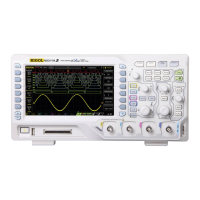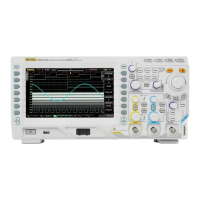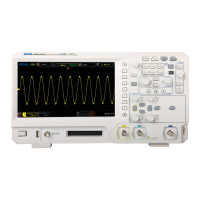RIGOL Chapter 2 Command System
2-114 MSO1000Z/DS1000Z Programming Guide
4. Voltage Parameters
The voltage value from the highest point of the waveform to the GND.
The voltage value from the lowest point of the waveform to the GND.
The voltage value from the highest point to the lowest point of the waveform.
The voltage value from the flat top of the waveform to the GND.
The voltage value from the flat base of the waveform to the GND.
The voltage value from the top of the waveform to the base of the waveform.
The actual voltage value corresponding to the threshold maximum value.
The actual voltage value corresponding to the threshold middle value.
The actual voltage value corresponding to the threshold minimum value.
The arithmetic average value on the whole waveform or on the gating area. The
calculation formula is as follows:
is the measurement result of the ith point,
is the number of points
being measured.
The root mean square value on the whole waveform or the gating area. The calculation
formula is as follows:
is the measurement result of the ith
point,
is the number of points
being measured.
The ratio of the difference between the maximum value and top value of the waveform
to the amplitude value.
The ratio of the difference between the minimum value and base value of the waveform
to the amplitude value.
The root mean square value within a period. For the calculation formula, please refer to
"Vrms".
The average of the sum of the squares for the difference between the amplitude value
of each waveform point and the waveform average value on the whole waveform or on
the gating area. The variance reflects the fluctuation degree of the waveform. The
calculation formula is as follows:
2
=1
( - )
n
i
Vamp(i) Average
Variance =
n
is the amplitude of the ith point,
is the average value of
the waveform,
is the number of points being measured.

